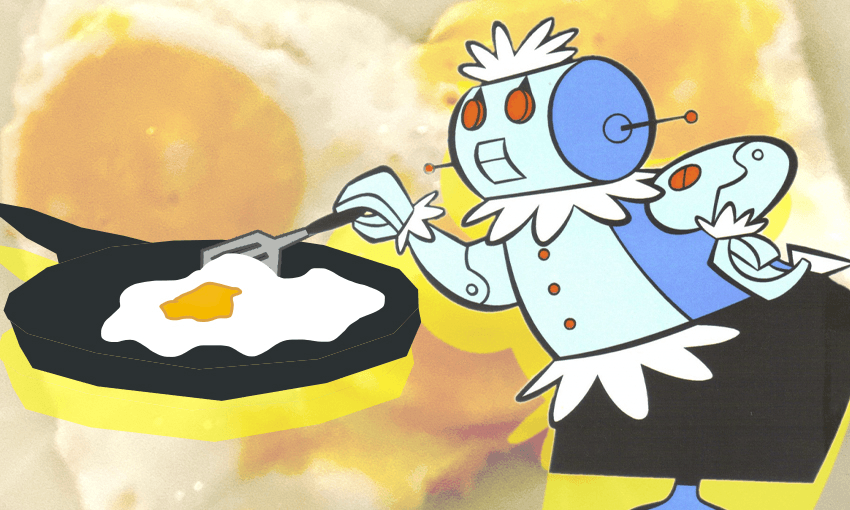Industrial robots can make our cars and planes, but for some reason the sight of a mechanical omelette machine filled Duncan Greive with existential dread.
I wandered into the restaurant trying not to look too keen. It was an entirely futile exercise – the M Social’s kitchen had been open for breakfast for exactly two minutes, so the staff all knew I was a fiend, and besides, the other guests had the same affliction anyway.
I had barely got 10 metres before I saw it. A glass case roughly the size of phone booth, though significantly more squat. Outside the glass were stacked plates and finely diced carrot, chicken and onion. Inside were trays of eggs, a frying pan, a hotplate – and a large metal arm holding a spatula.
Still half-asleep, I blinked and looked around, wondering if it was just a temporarily abandoned station with a seriously over-engineered utensil rack. Then the guy in front of me hit a button marked ‘omelette’ and the arm lurched into action. There was no denying it: this was a robot, here to cook some eggs.
Its name is AUSCA, and it’s a Singaporean innovation, pioneered in 2017, the product of private research and public funding. The man stood, transfixed and blocking my view, while I shifted my weight from foot to foot, anxious to see it in action.
In around three minutes, it was my turn. I chose ‘sunny side’, hit the button, and stood back to watch it at work. Its motion was curiously violent, given the delicacy of its task. After picking a pair of eggs up in its eerie soft plastic fingers, its joints and limbs whirled across to the small rectangular frypan. It paused and tilted briefly, before slamming the first egg down on a bar above the pan, allowing the contents to drain in. So far it was a flawless exercise. I’d read about Zume, a robotic pizza company, but the reviews had been indifferent, and I hadn’t expected to see one in front of me. The first egg suggested food robotics might be a lot further advanced than I’d thought.
The next didn’t go so smoothly. Immediately it became clear that there had been an execution issue. One egg’s yolk was pristine, glassy and whole. The other’s a smudged mess, irrecoverably split.
For a minute or so the arm dangled, poised above the mess of yolk and white. Then it went in for the crucial flip.
A bad chef, I’d taken years to master a clean flip back and forth. Perhaps the robot needs a similar span. It smooshed the contents halfway across, leaving a significant part of the mixture unflipped. After 30 seconds or so longer it picked the mess up and deposited it on my plate. Most of it was cooked through, but a guilty puddle of clear, viscous fluid betrayed its failure.
I took the eggs on a tour of the rest of the human-made buffet, as if to scold them for their imperfection. A crispy hash brown joined them, and some perfect little croissants. Then I took the plate back to my table, scraped what I could from the surface, and ate the robot’s eggs. They were not great.
I decided to give it another shot. Maybe it was just bad luck, or a bad egg. I loaded up a little wire mesh tea strainer-looking thing with onion and carrot (no cheese?!) and hit the omelette button. It fried up the onion and carrot first, which makes sense I guess, but proceeded to dump the eggs on top, creating a kind of moulded rectangular fry up, rather than the classic flipped over omelette. It tasted thin and empty, and I left the room in a low mood, ruing that technology, not content with destroying my industry, had now stolen a much-anticipated breakfast from me.
The trip to Singapore had otherwise been a culinary delight. The M Social is utterly charming, tiny rooms with everything you need and nothing you don’t, and a restaurant with the Impossible burger on the menu.
I’d wanted to try the plant-based patty for years, due to its reputation for being indistinguishable from beef. It lived up to billing, juicy and tender, tasting so good I had another for dinner at a restaurant on the river. Turns out Singapore is riddled with the much-buzzed about fake meat, and the second was two hand-made patties in a Big Mac-ish style, even better than the first. I finished it thinking that New Zealand needs to step up its transition away from cows, because there’s already a 3D-printed steak on the horizon. Once steaks join burgers, beef seems in serious trouble.
It’s a sign of the transformation of food which will sweep the world over the next decade, radically impacting supply chains, diets and the world economy. Yet the following morning brought eggs so bad I could have cooked them myself – a gluggy reminder that not all the food revolution is ready for battle just yet.

